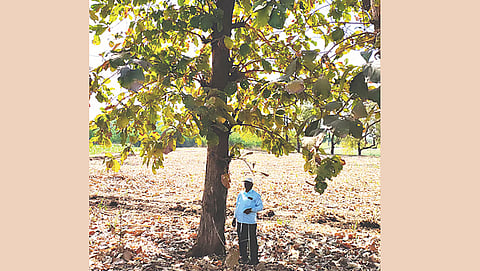

Look for strong, durable wood, and teak tops the list. Often called the “king” of timbers, teak (Tectona grandis) is one of the world’s most valuable tropical hardwoods, with applications ranging from shipbuilding to construction to high-end furniture.
Asia holds over 95 per cent of the world’s teak resources, with India alone managing 35 per cent of planted teak forests. As per the “Global Teak Resources and Market Assessment 2022”, published by the UN Food and Agriculture Organization (FAO), Madhya Pradesh and Maharashtra have the largest area of natural native teak forests, with average mean annual increment (MAI, the average annual growth of a tree or stand of trees) in most regions below 12 cubic metres per hectare per year (m³/ha/year). In favourable growing conditions, MAI of 10-12 m³/ha/year is ideal. But since green felling of timber from government-owned forests is prohibited under the Forest Conservation Act, 1980, and National Forest Policy, 1988, private plantations are relied upon to meet the growing domestic and international demand for this prized timber. However, poor productivity of planted teak cripples this prized agroforestry sector.
India’s productivity issues with teak are highlighted in a chapter of a 2024 book published by FAO. “Natural regeneration of teak largely depends on seeds, but several factors hinder large-scale propagation through this method, including low fruit production, poor seed viability, and low germination rates,” says the chapter by researchers from the Institute of Forest Genetics and Tree Breeding (IFGTB), Coimbatore. “Conventional vegetative propagation methods such as rooting of cuttings, grafting, and budding also have limitations due to low success rates and poor rooting ability in older trees,” it adds. In view of these issues, researchers and private players promote tissue culture propagation for teak, with claims that it can yield more profit and returns in eight to 12 years. Besides, tissue culture helps create genetically superior, disease-free plants, says the IFGTB paper.
In India, tissue culture research in teak was pioneered in the 1970s, followed by extensive efforts by the National Chemical Laboratory (NCL), Pune, in the 1980s-90s. There are several protocols in place; for instance, in 2005, the Indian Council of Agricultural Research-Central Research Institute for Dryland Agriculture, Hyderabad, established a method to culture nodal explants (tissues) from juvenile shoots of mature trees. The protocol has four stages: establishment of primary explants, in vitro multiplication, rooting and hardening (acclimatisation).
Currently, over 200 tissue culture laboratories in India produce teak saplings. But does tissue culture really guarantee accelerated growth and higher productivity? This question cannot be answered in the absence of long-term field studies. Despite extensive forestry research, there is no comparative study lasting more than 25 years on growth, quality and economic returns from tissue-cultured teak.
Our analysis of documented trials provides certain insights. First, success stories are subjective and cannot be generalised. A 2011 paper by a researcher from NCL reports excellent growth of tissue-cultured teak at a farmer’s field near Sangli, Maharashtra. In eight years, trees grew 8-10 m in height and 60-70 cm in girth with a high degree of uniformity. However, the paper notes that adjacent plots with tissue-cultured teak obtained from a private company in southern India showed poor growth, high variability and high mortality rates.
Second, the type of plantation can determine the economic potential. A 2021 study in the Indian Journal of Agroforestry analyses three different teak plantation systems in Karnataka: intensively managed (planted at 4x4 m spacing), boundary or line (4 m spacing), and unmanaged (2x2 m spacing). Intensively managed plantations received proper irrigation, fertilisers and good agricultural practices, while line plantations saw minimal maintenance. Unmanaged plantations were left to grow naturally. At 24-25 years old, the amount of usable wood per tree was 0.22 m³ in unmanaged plantations, 0.54 m³ in line plantations, and 0.85 m³ in intensively managed plantations. The benefit-to-cost ratio was highest for unmanaged plantations (3.73) due to lower costs, followed by intensively managed (2.56) and line plantations (1.59). But net present value (at 8 per cent discount rate) was highest for intensively managed plantations at R9.38 lakh, followed by R5.5 lakh for unmanaged and R1.71 lakh for line plantations. This suggests planting teak at appropriate spacing and good practices gives higher economic returns than denser spacing without proper maintenance.
The study also shows that in 20-odd years, even with intensive management, teak yields were 5-10 m3/ha/year. This raises questions about claims of tissue-cultured teak showing higher yields in shorter cycles. For instance, Mother Agri Biotech, a company in Chikkaballapur, Karnataka, recommends planting 440 trees per ha. It says teak starts yielding at eight, 12 and 18 years, producing 0.7 m3, 2.12 m3 and 4.24 m3 of wood per tree respectively. Another company, National Green Biotech, claims within eight years of planting 600 trees per acre (0.4 ha), each tree can produce 0.76 m3 of wood. These claims need verification and certification, as no forestry research institution in India recommends a 10- or 15-year rotation period for teak.
While tissue culture shows promise, further research is needed to evaluate its long-term effectiveness under diverse field conditions.
(SB Chavan is senior scientist, forestry/agroforestry, Indian Council of Agricultural Research or ICAR-National Institute of Abiotic Stress Management, Baramati. AR Uthappa is scientist, agroforestry, ICAR-Central Coastal Agricultural Research Institute, Goa. Keerthika A is scientist, agroforestry, ICAR-Central Arid Zone Research Institute, Jodhpur)
This was first published in the 1-15 April, 2025 print edition of Down To Earth